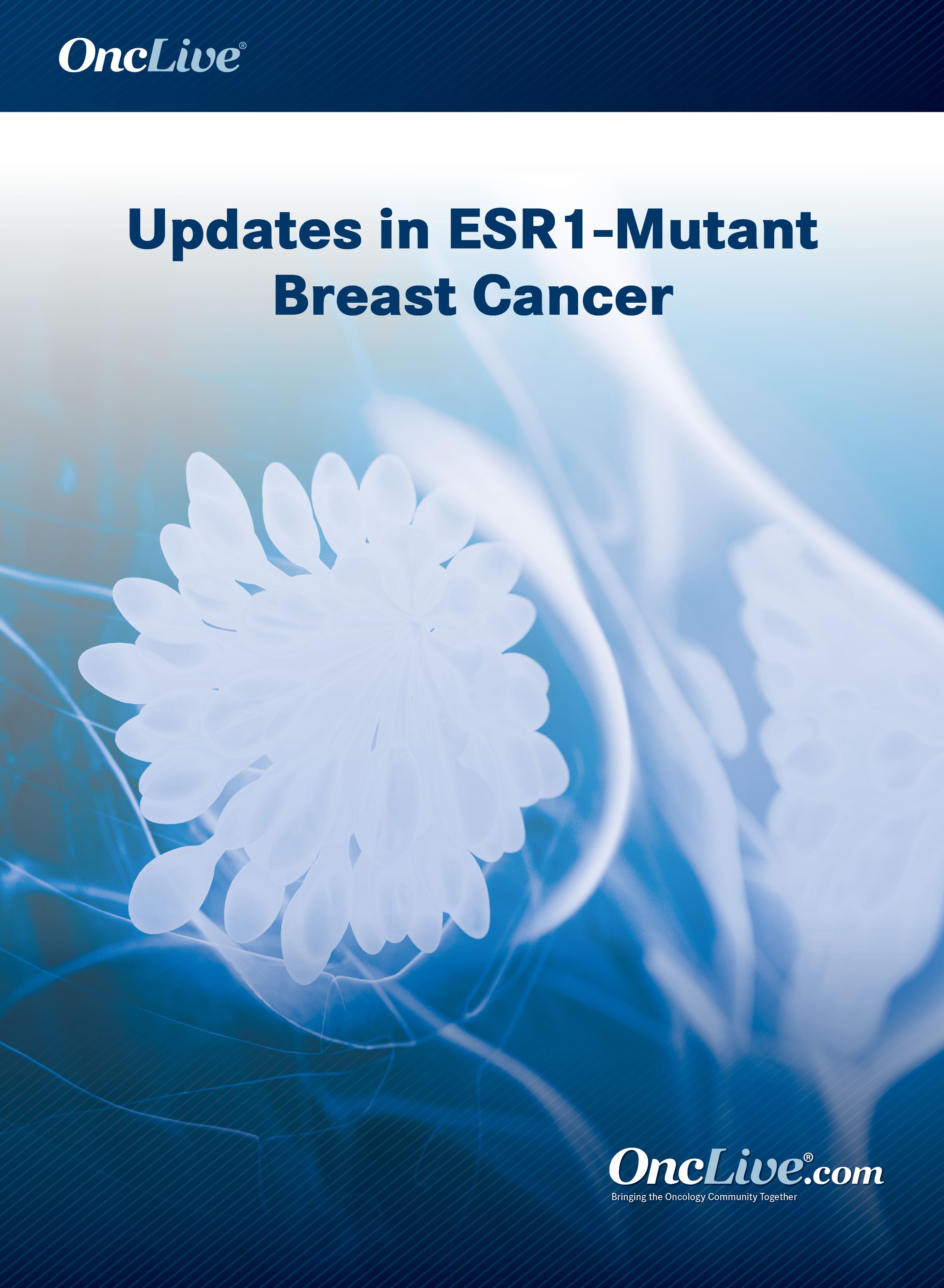Publication
Article
Supplements and Featured Publications
ELAINE-2 Trial Could Establish the Actionability of ESR1 in HR+/HER2- Breast Cancer
Author(s):
Matthew P. Goetz, MD, discusses ongoing research in the setting of ESR1-mutant, ER–positive, HER2-negative metastatic breast cancer.
Matthew P. Goetz, MD

The ongoing ELAINE-2 trial (NCT04432454), which is evaluating the combination of lasofoxifene and abemaciclib (Verzenio) in patients with ESR1-mutant, estrogen receptor (ER)–positive, HER2-negative metastatic breast cancer, is building on findings from the ELAINE study, which demonstrated that the oral selective estrogen receptor modulator (SERM) has significant preclinical antitumor activity in ESR1-mutant models, said Matthew P. Goetz, MD. Positive findings from the trial would not only confirm ESR1 as an actionable target but demonstrate the viability of sequential CDK4/6 inhibition after progression.
“I think lasofoxifene is probably the leading SERM to be studied in the setting of ESR1 mutations,” said Goetz. “The suggestion from the preclinical data is that the combination of lasofoxifene and a CDK4/6 inhibitor should be a reasonable option. The idea of combining abemaciclib or another CDK4/6 inhibitor with lasofoxifene is being tested in the ELAINE-2 study. One would fully expect this to be a well-tolerated and safe regimen, just like when you combine a new CDK4/6 inhibitor with other endocrine therapy partners.”
In an interview with OncLive, Goetz, consultant, Division of Medical Oncology, Department of Oncology, Mayo Clinic, discussed ongoing research in the setting of ESR1-mutant, ER–positive, HER2-negative metastatic breast cancer.
OncLive: Does the presence of an ESR1 mutation make you more prone to continue or switch a CDK4/6 inhibitor?
Goetz: Among patients who are progressing on a CDK4/6 inhibitor, one of the major questions that we have is: What are the drivers? What is driving resistance? A number of biomarkers have been identified to be present at the time of progression. These include biomarkers, such as ESR1 mutations, RB alterations, and certainly cyclin E is a biomarker that suggests that an alternative pathway, including CDK2 may be important.
When it relates to the ESR1 mutations that are developing at the time of progression, we have to ask: Is ESR1 a driver? If it is a driver, what is the best way to treat that particular patient? Continuing on with the CDK4/6 inhibitor certainly may be a very important treatment strategy. But at this point, it is one that we don’t know the answer to.
A number of studies are ongoing right now that are really trying to answer the question of: Should you continue a CDK4/6 inhibitor beyond progression? For example, in patients who progress on a CDK4/6 inhibitor, is there a role for switching out the endocrine therapy, and continuing on with the CDK4/6 inhibitor? A number of studies are looking at this question. In the presence of an ESR1 mutation where there is ligand independent growth of the tumor, continuation of the CDK4/6 inhibitor certainly may be important. We just don’t know the answer to that right now.
How is genomic information currently being used to guide treatment? Is there a preference between using liquid biopsy and tissue biopsy?
It’s a great question. Certainly, genomic information has rapidly become a critical component of how we manage patients with metastatic ER–positive breast cancer. This, of course, is based on the fact that a number of genetic alterations are targetable. For example, we have data with alpelisib [Piqray] in PIK3CA alterations, and we know that this drug has antitumor activity in tumors that that have the PI3 kinase or pathway activated, say through a PIK3CA alteration. We also know from SOLAR-1 that we can assess from the tumor or through ctDNA [circulating tumor DNA]. We also know that there are patients in our clinic where the tumor is not readily accessible. These are, for example, patients with bone only disease.
Assessing for a genomic alteration through ctDNA analysis is a very attractive way to be able to assess the current state of that particular tumor. This is part of our standard of practice right now to assess for these genomic alterations. We have targets including PIK3CA and BRCA1/2. With regard to ESR1, we have yet to have an FDA-approved drug, but we have hints that using specific drugs may be of value. For example, drugs, such as SERDs [selective estrogen receptor downregulators] or in the case of a SERM, lasofoxifene.
How do the SERMs compare with SERDs? What distinguishes lasofoxifene from other SERMs?
It’s another great question. We have many oral SERDs that are making their way through clinical trials. One of the ways that these oral SERDs are quite attractive is the fact that they’re able to achieve very good pharmacokinetic concentrations that are associated with excellent ER degradation. The idea here is that ER degradation should be a superior way to treat a tumor that has, in this case, a ESR1 alteration, and we know that preclinically that indeed is the case. There are many studies demonstrating that these oral SERDs have antitumor activity.
Lasofoxifene is of course is a SERM. It binds to the ER, but one of the things that we know about lasofoxifene is that at the higher concentrations that are being tested, for example, in the ELAINE study, which is a randomized trial comparing lasofoxifene with fulvestrant [Faslodex], that at the dose, and at the concentrations that are being used in the ELAINE study, that lasofoxifene has been shown preclinically at those concentrations to have substantial antitumor activity in ESR1-mutated models.
Specifically, in work that came out of Dr Jeff Greene’s laboratory comparing, for example, lasofoxifene with fulvestrant, lasofoxifene was superior in terms of inhibiting metastases.
We have these 2 approaches right now: one of them is using these potent SERDS, and another is utilizing lasofoxifene. Why does lasofoxifene have antitumor activity in this setting? Well, some of the preclinical data really suggest that lasofoxifene maintains its ability to bind, even to the mutated ER, and in that particular setting is able to reduce proliferation, and ligand independent proliferation. This beneficial effect of lasofoxifene is what is being tested in the randomized phase 2 ELAINE study.
Lasofoxifene is also being evaluated in combination with abemaciclib in the ELAINE-2 study. Why was abemaciclib selected as the combination partner?
The most common CDK4/6 inhibitor that is being used probably out in the community right now in the first-line setting is, of course, palbociclib [Ibrance]. Practically, one of the easy things that can be done in this situation is for patients who are progressing on palbociclib is to combine, for example, lasofoxifene with abemaciclib. This is of course, a very attractive regimen that physicians can think about using because ESR1 mutations are commonly occurring at the time progression on palbociclib and abemaciclib has been shown to have some antitumor activity in the post-palbociclib setting. It’s not FDA approved in that particular setting, but certainly this combination is quite attractive from that standpoint.
Would you say lasofoxifene is the primary player right now or are there other agents to look out for?
The SERMs that have been tested in the endocrine-refractory setting that have shown benefit include the drug endoxifen, which was studied in a randomized phase 2 study. These data were presented at the 2019 San Antonio Breast Cancer Symposium. In that particular study, endoxifen did not lead to a statistically significant improvement in progression-free survival vs tamoxifen. However, there was an interesting analysis in patients who had no prior CDK4/6 inhibitors, and in that setting, endoxifen was markedly better by about 5 months.
With regard to endoxifen, there are no data or very limited data right now with regard to its role in [patients with] ESR1 mutations. That is something that will be tested in a randomized phase 2 study, but ELAINE and ELAINE-2 are really the players that we need to emphasize.
What other studies were you most excited to see the results of at the 2020 San Antonio Breast Cancer Symposium?
In thinking about CDK4/6 inhibitors, there was an update on the monarchE study. The second interim analysis was presented at the 2020 European Society for Medical Oncology Annual Congress and published in the Journal of Clinical Oncology. At SABCS, we saw the primary analysis of invasive disease-free survival as well as data on Ki-67. One of the interesting things that was done in the monarchE study was that there was a prespecified group of patients that were enrolled with very high Ki-67 greater than 20%. We’re going to see some of the data with regard to the potential benefit of abemaciclib in this high group.
The other abstract that I’m very interested in hearing about is the RxPONDER study, which is a randomized clinical trial in the adjuvant setting for high-risk, ER-positive breast cancer that’s node positive. The randomization was to chemotherapy vs not based on Oncotype Dx recurrence scores. Of course, we have data from TAILORx in the node-negative setting. We’ve been awaiting these data in the node-positive setting for some time, so we’re anxious to see these data as well.










